Family : Falconidae

Text © Dr. Gianfranco Colombo

English translation by Mario Beltramini
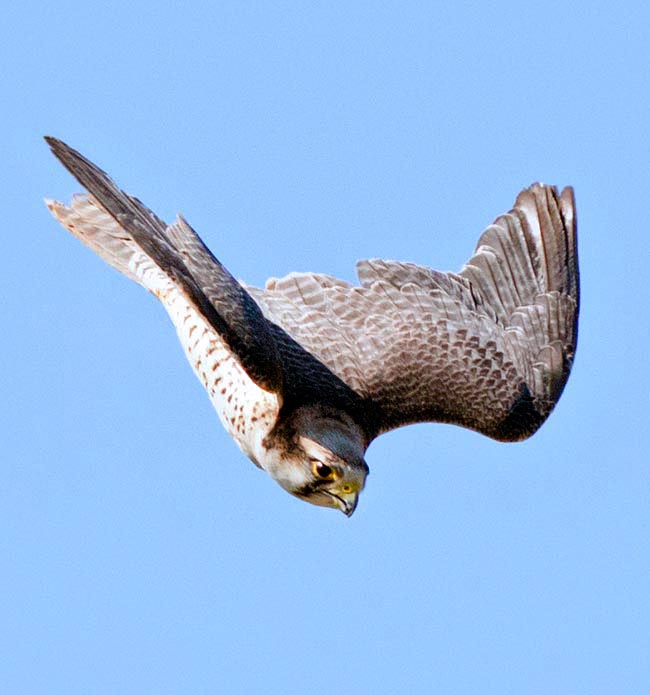
Rare in Mediterranean Europe, the Falco biarmicus is an Afro-Asiatic sedentary bird © Giuseppe Mazza
The Lanner falcon (Falco biarmicus Temminck, 1825) belongs to the order of the Falconiformes and to the family of the Falconidae.
In this family are included all those Falconiformes vulgarly placed in the group of the “long wings” raptors and that is the real and proper hawks (genus Falco, etc.), distinguishing them from the “short wings” ones (genus Accipiter, etc.) from the “broad wings” ones (genera Aquila, Buteo, etc.) all assigned to the family of the Accipitridae.
Both vulgar Italian name and the scientific one of the lanner falcon, have generated different and intriguing interpretations that have made the XIX century ornitologists debating for decades.
As a matter of fact we might say that the original guilt was of the imperishable Linnaeus who, in 1758, with remarkable fantasy, invented the term biarmicus for another bird, rightly, the bearded reedling, thePanurus biarmicus.
At that time it was thought that this small bird was coming from an imaginary North Europe area called Bjarmia (Bjarmaland in old Norse) which was to be located around the White Sea.
When Temminck thought to this name for the lanner falcon, raptor that, of course, has never been present in that area, interpreted the intentions of Linnaeus in a completely different way imagining that biarmicus came from a supposed “bis-armicus”, by him intended as “two moustaches”, rightly the characteristic Linnaeus had found in the bearded reedling.
Therefore, he classified the lanner falcon with the same concept with the specific name biarmicus rightly because it had two big facial drawings similar to moustaches.
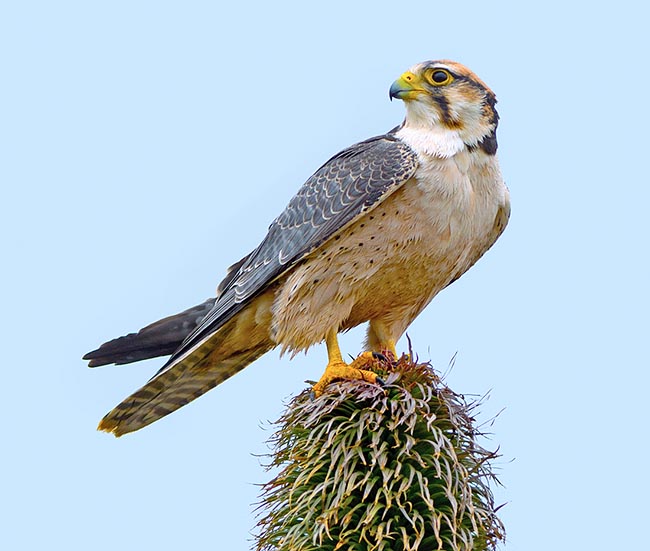
It’s an elegant falcon, more slimmer than its congeners, living in open areas and in a wide variety of habitats © Gianfranco Colombo
Finally, there is a last interpretation about this name that concerns the fact that this raptor along with many members of its family, has a beak equipped on the upper blade with an additional tooth, rightly “bi-armicus” = double weapon.
For what concerns the generic term Falco the etymology is clear and exhaustive: falcate wings, that is sickle-shaped, hence falco.
Also the vulgar term lanner has its own nice history.
The first version, nowadays set aside, sustained that this name came from the old French “lanier” = weaver, a term that had also the second sneaky and hateful meaning of an ignoble or minor person. And it is for this reason that they gave this nickname as, being a very stubborn bird, it was difficult to train it for the falconry. Then, simply, a little worth animal.
The second version, instead, gives credit to this magnificent predator that, even if considered as sluggish, shows on the contrary the typical ferocity of the predators. A simple anagrammatic distorsion of “lanarius”, from the Latin to rend, to tear or from “lanius”, butcher, rightly, the correct description of its way of hunting.
The European names trace all these interpretations. In English Lanner falcon; in German Lannerfalk; in French Faucon lanier; in Spanish Halcòn Bornì and in Portuguese Alfaneque.
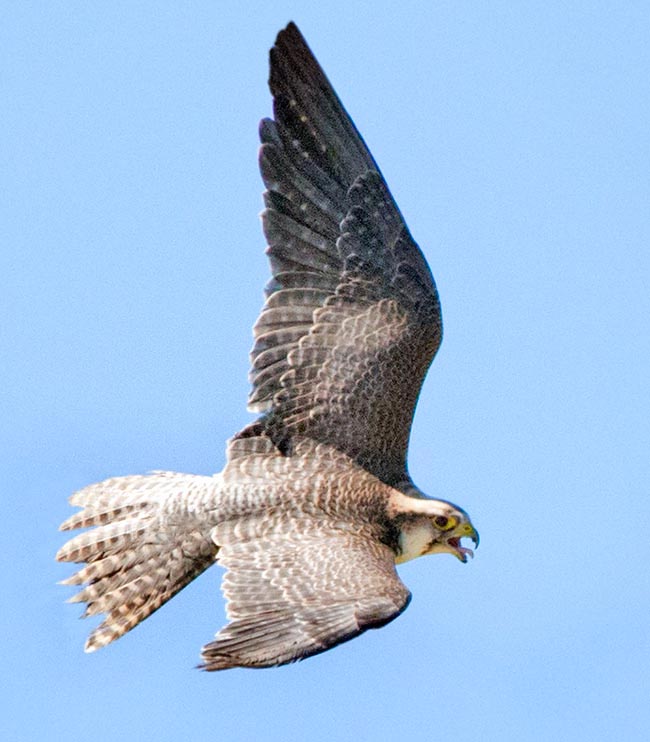
Has a slow and relaxed oberving flight to then swoop like a lightning on land preys or looking for food on the soil. Vocalizations are quite various, confusing at times with the peregrine falcon © Giuseppe Mazza
The lanner falcon has two congeneric species rather similar each other in the flight as well as in the behaviour, the peregrine falcon (Falco peregrinus) and the saker falcon (Falco cherrug).
These three raptors due to their very relevant characteristics have entered forcefully the world of the falconry and there is no battery without them.
As already mentioned, three birds similar each other but with small morphological particulars giving them individually those peculiarities rendering them desired to the most refined falconers.
The lanner falcon the calm and the serenity; the peregrine the strength and the rapidity; the saker the determination and the perseverance.
Unfortunately, this activity has led to the ignoble habit of predating the nests done by sinister merchants who deal them in the Arabic countries where the relevant legislation is rather reduced or even absent.
Sadly, this illegal taking has carried and is carrying this raptor to the extinction in some areas, especially in the European and Middle Eastern ones, where the population is already reduced by its nature.
Zoogeography
The lanner falcon is an Afro-Asiatic bird. It lives in all the African continent, in some areas of the Middle East and of the Arabic Peninsula and in reduced and poor populations, in the European regions of the eastern Mediterranean going from Italy to the Balkan peninsula. It is totally missing in the rest of Europe.
Despite having such a vast range, it is a rather scarce raptor and not always easy to see even in the frequented territories. We cannot then consider it as a common bird in particular in the European area where its presence is characterized by small colonized zones interspersed with vast areas where it’s since always absent.
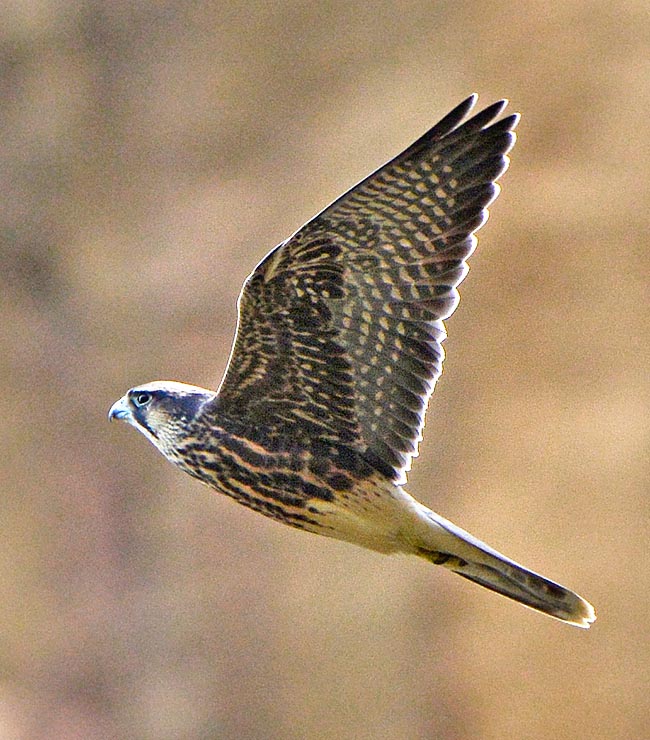
The young have a much more spotted chest and are darker than the adults © Gianfranco Colombo
Typically, it is a sedentary bird but in some ranges it often undertakes short periodic trips maybe caused by the variation of the climatic conditions.
Five subspecies have been classified:
Falco biarmicus biarmicus typically central African
Falco biarmicus feldeggi of the North-Mediterranean area
Falco biarmicus abyssinicus of Western Africa
Falco biarmicus tanypterus of Middle East and Arabic Peninsula
Falco biarmicus erlangeri of Northern Africa.
Small populations, probably stable since centuries, are present in the Italian Peninsula but their number is rather reduced though diffused.
It goes north up to the Tuscan-Emilian Apennine that seems to be its boreal limit. Conversely, it’s absent in Sardinia.
Ecology-Habitat
The lanner falcon lives usually in open areas but with a remarkable variety of habitats going from predesert areas to humid zones, from mountain forests to sparse woods, from cultivated zones to urban settlements.
It may get close to the 5000 m of altitude on the Ethiopian highlands of Bale Mountains and the Semien Mountains.
Even if present in many habitats, its preference is anyway concentrated on stony sites with sparse vegetation and few herbaceous essences, often at the limit of the deserts and perhaps this is the reason that at times it is observed while flying over cultivated areas that probably are seen for their open spaces and periodically missing of vegetation, as a simple repetition of its preferred habitats.
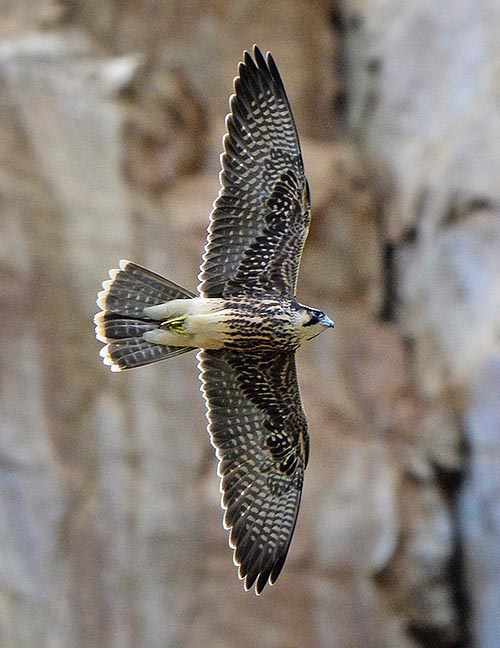
Again a young specimen. The females, as usual for raptors, are bigger and may reach 110 cm of wingspan with even 900 g of weight © Gianfranco Colombo
It is a regular visitor to these areas only for getting the preys but basically isolates when is the moment of the nidification preferring zones without anthropic disturbance even if in some areas it gets closer for the nesting, to the urban settlements.
Morpho-physiology
The lanner falcon is a quite elegant hawk with a more slender structure and a slimmer silhouette than its congeners.
It has a much slower and relaxed flight and tends more to perform pirouettes at low speed accelerating only at the moment of the discovery of a prey on which it swoops, like the peregrine and the saker falcons, with the usual ferocity of a falcon and the amazing speed of a lightning. On this point it is no less of its similars.
Basically, the preys are seized on the ground and perhaps for this reason its victims are mainly terrestrial or are momentarily on the soil for feeding. The lanner falcon, unlike its two congeners, nourishes of small preys preferably terrestrial birds, pigeons and small crows but does not disdain in catching also reptilians, insects and small rodents.
Maybe for this reason, as mentioned before, it was in the past considered not too suitable for the falconry, a sport that even now looks for, besides the expression of power of the chosen raptor also a concrete evidence of the hunting abilities of the same.
In any case, the lanner falcon has dimensions by sure not nebligible for a raptor, having a length that in the females, who are markedly more robust than the partner, may reach the 50 cm, a wingspan of 110 cm and a weight varying in the sexes from 500 to 900 g.
The adults have the chest of pinkish white colour finely dotted by blackish spots, metallic grey back and black barred tail in contrast with the covering colour slightly paler on the back. Having a fairly pronounced tail, the length of the resting wings is slightly shorter than this one. The head is hooded of reddish hazel colour, more greyish in the female, with two narrow black and well visible moustaches coming down on the cheeks. Feathered yellow paws with much elongated fingers equipped with big black claws.
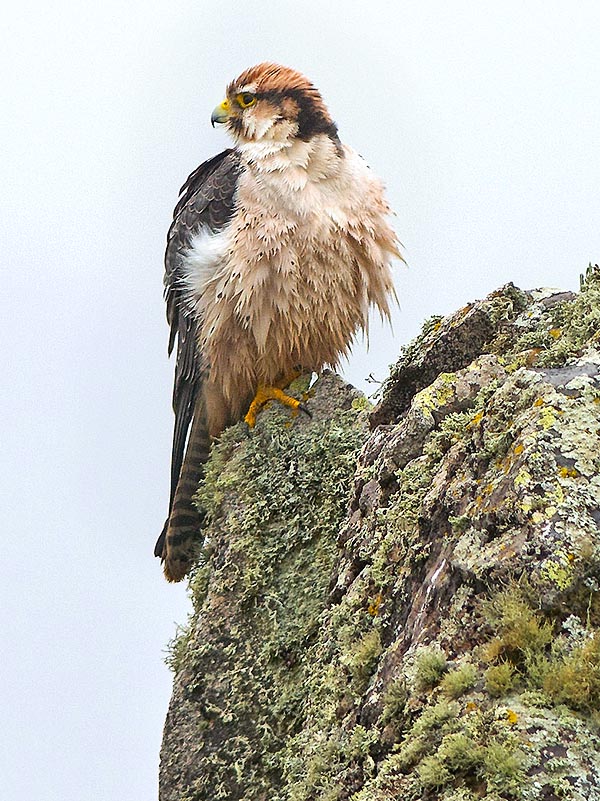
Falco biarmicus, here a chilly adult, can go up to almost 5000 metres on the Ethiopian highlands of Bale Mountains and of Semien massif. It’s an unscrupolous opportunist for the nest © Gianfranco Colombo
The young have a much more spotted chest and are darker than the adults.
Ethology-Reproductive Biology
The lanner falcon is a good opportunist in finding the place suitable for the nidification. In most cases it builds the nest in covered rocky recesses, placed on inaccessible walls but when the occasion arises it does not disdain in encroaching old crows nests or nests of other raptors or herons.
Also, without any fear or prudery it builds it on the soil in some desert areas where it does not find both situations and where the absence of rains, does not create adverse problems.
It is not rare, then, to see them, in particular in North Africa on façades of ancient ruined monuments or abandoned turrets or on towered summits of tall minarets in the suburbs of urban centres, as well as also on high pylons.
It lays 3 to 4 eggs that usually are hatched only by the female for about 5 weeks.
As usual for many falconids, the male usually goes hunting also for the female carrying the food for the whole above period.
The chicks stay in the nest for 6-7 weeks but remain linked to the parents until the maturity that is reached when two to three years old.
The adults nidification occurs annually and takes place in different periods of the year depending on their geographical location and despite the pair keeps often united also during this period, it is thought that this bird of prey is not strictly monogamous.
Synonyms
Falco lanarius Temminck, 1825.
→ To appreciate the biodiversity within the birds of prey and find other species please click here.
